Related Research Articles

Kohlrabi, also called German turnip, is a biennial vegetable, a low, stout cultivar of wild cabbage. It is another cultivar of the same species as cabbage, broccoli, cauliflower, kale, Brussels sprouts, collard greens, Savoy cabbage, and gai lan.

Cabbage is a leafy green, red (purple), or white biennial plant grown as an annual vegetable crop for its dense-leaved heads. It is descended from the wild cabbage, and belongs to the "cole crops" or brassicas, meaning it is closely related to broccoli and cauliflower ; Brussels sprouts ; and Savoy cabbage.

Broccoli is an edible green plant in the cabbage family whose large flowering head, stalk and small associated leaves are eaten as a vegetable. The word broccoli comes from the Italian plural of broccolo, which means "the flowering crest of a cabbage", and is the diminutive form of brocco, meaning "small nail" or "sprout".

Brassica is a genus of plants in the mustard family (Brassicaceae). The members of the genus are informally known as cruciferous vegetables, cabbages, or mustard plants. Crops from this genus are sometimes called cole crops—derived from the Latin caulis, denoting the stem or stalk of a plant.
Cauliflower is one of several vegetables in the species Brassica oleracea in the genus Brassica, which is in the Brassicaceae family. It is an annual plant that reproduces by seed. Typically, only the head is eaten – the edible white flesh sometimes called "curd". The cauliflower head is composed of a white inflorescence meristem. Cauliflower heads resemble those in broccoli, which differs in having flower buds as the edible portion. Brassica oleracea also includes broccoli, Brussels sprouts, cabbage, collard greens, and kale, collectively called "cole" crops, though they are of different cultivar groups.

The Brussels sprout is a member of the Gemmifera Group of cabbages, grown for its edible buds.

Brassica oleracea is a plant species that includes many common foods as cultivars, including cabbage, broccoli, cauliflower, kale, Brussels sprouts, collard greens, Savoy cabbage, kohlrabi, and gai lan.

Sulforaphane is a compound within the isothiocyanate group of organosulfur compounds. It is obtained from cruciferous vegetables such as broccoli, Brussels sprouts, and cabbages. It is produced when the enzyme myrosinase transforms glucoraphanin, a glucosinolate, into sulforaphane upon damage to the plant, which allows the two compounds to mix and react. Young sprouts of broccoli and cauliflower are particularly rich in glucoraphanin.

Cruciferous vegetables are vegetables of the family Brassicaceae with many genera, species, and cultivars being raised for food production such as cauliflower, cabbage, kale, garden cress, bok choy, broccoli, Brussels sprouts, and similar green leaf vegetables. The family takes its alternative name from the shape of their flowers, whose four petals resemble a cross.

The acephala group refers to any type of Brassica which grows without the central 'head' typical of many varieties of cabbage. These are included within the species Brassica oleracea, such as Kale. The name literally means "without a head" in contrast to those varieties known as capitata or "with a head". This group includes a number of species, both wild and cultivated, many of which are grown for their edible leaves and flowers.
The BBCH-scale is used to identify the phenological development stages of plants. BBCH-scales have been developed for a range of crop species where similar growth stages of each plant are given the same code.
In biology, the BBCH-scale for bulb vegetables describes the phenological development of bulb vegetable plants, such as onion, leek, garlic and shallot, using the BBCH-scale.
The BBCH-scale (potato) identifies the phenological development stages of a potato. It is a plant species-specific version of the BBCH-scale.
The BBCH-scale for root and stem vegetables identifies the phenological development stages of the root and stem vegetables such as carrot, celeriac, kohlrabi, chicory, radish and swede, using the BBCH-scale.
In biology, the BBCH-scale for leafy vegetables forming heads describes the phenological development of leafy vegetables forming heads, such as cabbage, chinese cabbage, lettuce and endive, using the BBCH-scale.
In biology, the BBCH-scale for leafy vegetables not forming heads describes the phenological development of leafy vegetables not forming heads, such as spinach, loosehead lettuce, and kale, using the BBCH-scale.

Hyaloperonospora brassicae, in the family Peronosporaceae, is a plant pathogen. It causes downy mildew of species of Brassica, Raphanus, Sinapis and probably other genera within the Brassicaceae. In the past, the cause of downy mildew in any plant in the family Brassicaceae was considered to be a single species Peronospora parasitica. However, this has recently been shown to be a complex of species with narrower host ranges, now classified in the genus Hyaloperonospora, for example Hyaloperonospora parasitica on the weed Capsella bursa-pastoris. From the perspective of plant pathology, Hyaloperonospora brassicae is now the name of the most important pathogen in this complex, attacking the major agricultural and horticultural Brassica species. Other significant Brassicaceous hosts are attacked by different species in the complex, e.g. horseradish by Hyaloperonospora cochleariae, wallflower by Hyaloperonospora cheiranthi.

Napa or napa cabbage is a type of Chinese cabbage originating near the Beijing region of China and is widely used in East Asian cuisine. Since the 20th century, it has also become a widespread crop in Europe, the Americas and Australia. In much of the world, this is the vegetable referred to as "Chinese cabbage". In Australia it also is referred to as "wombok".

Lipaphis erysimi is a species of aphid of the family Aphididae. Its common names include mustard aphid and turnip aphid. It is found in most temperate and tropical areas of the world and feeds only on cruciferous plants. The insects are almost exclusively female and are very prolific, with wingless females producing around one hundred young during a lifespan of a few weeks.
References
- C. Feller; H. Bleiholder; L. Buhr; H. Hack; M. Hess; R. Klose; U. Meier; R. Stauss; T. van den Boom; E. Weber (1995). "Phänologische Entwicklungsstadien von Gemüsepflanzen: I. Zwiebel-, Wurzel-, Knollen- und Blattgemüse". Nachrichtenbl. Deut. Pflanzenschutzd. 47: 193–206.